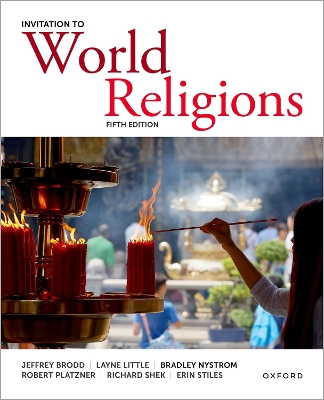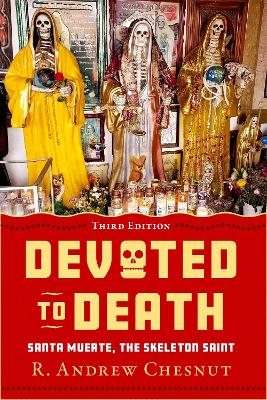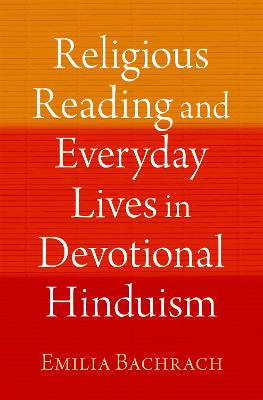Invitation to World Religions
 -10%
portes grátis
-10%
portes grátis
Invitation to World Religions
Brodd, Jeffrey
Oxford University Press Inc
12/2024
672
Mole
9780197771341
15 a 20 dias
Descrição não disponível.
Preface
Chapter 1. An Invitation to the Study of World Religions
1.1 Approaching the Study of World Religions
1.2 Defining "Religion"
1.3 What Religions Do
1.4 Religions in the Modern World Methods for Studying the World's Religions
1.5 Methods for Studying the World's Religions
Chapter 2. Indigenous Religions of North America
2.1 The Teachings of Indigenous Religious of North America: Core Precept
2.2 The Teachings of Indigenous Religions of North America: Humanity and the Environment
2.3 The History of Indigenous Religions of North America: Origins
2.4 The History of Indigenous Religions of North America: Conquest and Colonization
2.5 The History of Indigenous Religions of North America: The Modern Age
2.6 Indigenous Religions of North America as a Way of Life: Observance
2.7 Indigenous Religions of North America as a Way of Life: Life-Cycle Events
2.8 Indigenous Religions of North America as a Way of Life: Engaging with the World
Chapter 3. Indigenous Religions of Africa
3.1 The Teachings of Indigenous Religions of Africa: Sacred Narratives
3.2 The Teachings of Indigenous Religions of Africa: Humanity
3.3 The History of Indigenous Religions of Africa: Religion in Early Civilizations and States
3.4 The History of Indigenous Religions of Africa: The Spread of Islam and Christianity
3.5 The History of Indigenous Religions of Africa: The Transatlantic Slave Trade and African Religions in the Americas
3.6 The History of Indigenous Religions of Africa: Reform and Resistance
3.7 Indigenous Religions Of Africa as A Way of Life: Observance
3.8 Indigenous Religions Of Africa as A Way of Life: Engaging with the World
Chapter 4. Hinduism
4.1 The Teachings of Hinduism: Beliefs about Divine Reality
4.2 The Teachings of Hinduism: The Individual and the Quest for Liberation
4.3 The Teachings of Hinduism: The Individual and Society
4.4 The Teachings of Hinduism: Sacred Texts
4.5 The Teachings of Hinduism: Varieties
4.6 The Teachings of Hinduism: Origins
4.7 The History of Hinduism: Development
4.8 The History of Hinduism: The Modern Age
4.9 Hinduism as a Way of Life: Rituals and Observances
4.10 Hinduism as a Way of Life: Engaging with the World
Chapter 5. Buddhism
5.1 The Teachings of Buddhism: The Life and Teachings of the Buddha
5.2 The Teachings of Buddhism: Theravada Buddhism
5.3 The Teachings of Buddhism: Mahayana Buddhism
5.4 The Teachings of Buddhism: Five Mahayana Schools
5.5 The History of Buddhism: Asia
5.6 The History of Buddhism: The West
5.7 Buddhism as a Way of Life: Practices
5.8 Buddhism as a Way of Life: Engaging with the World
Chapter 6. Jainism
6.1 The Teachings of Jainism: Mahavira and the Tirthankaras
6.2 The Teachings of Jainism: Central Precepts
6.3 The History of Jainism
6.4 Jainism as a Way of Life: Varieties
6.5 Jainism as a Way of Life: Practices and Observances
6.6 Jainism as a Way of Life: Engaging with the World
Chapter 7. Sikhism
7.1 The Teachings of Sikhism: The Life of Guru Nanak
7.2 The Teachings of Sikhism: Sacred Texts
7.3 The Teachings of Sikhism: Core Precepts
7.4 The History of Sikhism: Development
7.5 The History of Sikhism: The Modern Age
7.6 Sikhism as a Way of Life: Devotional Practices
7.7 Sikhism as a Way of Life: The Life Cycle
7.8 Sikhism as a Way of Life: Engaging with the World
Chapter 8. Chinese Religions: Confucianism and Daoism
8.1 The Teachings of Chinese Religions: Before Confucianism and Daoism
8.2 The Teachings of Chinese Religions: Confucianism
8.3 The Teachings of Chinese Religions: Daoism
8.4 The History of Chinese Religions: Confucianism
8.5 The History of Chinese Religions: Daoism
8.6 Chinese Religions as a Way of Life: Rituals and Observances
8.7 Chinese Religions as a Way of Life: Engaging with the World
Chapter 9. Shinto
9.1 The Teachings of Shinto
9.2 The History of Shinto
9.3 Shinto as a Way of Life: Rituals and Observances
9.4 Shinto as a Way of Life: Engaging with the World
Chapter 10. Zoroastrianism
10.1 The Teachings of Zoroastrianism: Central Precepts
10.2 The Teachings of Zoroastrianism: Sacred Texts
10.3 The History of Zoroastrianism: Origins
10.4 The History of Zoroastrianism: From Ancient Times to the Present
10.5 Zoroastrianism as a Way of Life: Rituals, Holy Days, and Rites of Passage
10.6 Zoroastrianism as a Way of Life: Engaging with the World
Chapter 11. Judaism
11.1 The Teachings of Judaism: God, Torah Covenant
11.2 The Teachings of Judaism: The Messiah, the Afterlife, and Mysticism
11.3 The History of Judaism: The Ancient, Medieval and Premodern Eras
11.4 The History of Judaism: The Modern Era
11.5 Judaism as a Way of Life: Festivals, the Sabbath, and Life-Cycle Events
11.6 Judaism as a Way of Life: Other Sacred Practices
11.7 Judaism as a Way of Life: Engaging with the World
Chapter 12. Christianity
12.1 The Teachings of Christianity: Foundations
12.2 The Teachings of Christianity: Core Precepts
12.3 The History of Christianity: The Church in the Ancient Roman World
12.4 The History of Christianity: The Middle Ages
12.5 The History of Christianity: The Modern Era
12.6 Christianity as a Way of Life: Devotional Practices
12.7 Christianity as a Way of Life: Engaging with the World
Chapter 13. Islam
13. 1 The Teachings of Islam: Sacred Texts
13.2 The Teachings of Islam: Core Precepts
13.3 The History of Islam: Origins
13.4 The History of Islam: Development
13.5 The History of Islam: The Modern Age
13.6 The History of Islam: Different Ways of Being Muslim
13.7 Islam as a Way of Life: Observances
13.8 Islam as a Way of Life: The Islamic Year and Holidays
13.9 Islam as a Way of Life: Family and Community
13.10 Islam as a Way of Life: Engaging with the World
Chapter 14. New Religious Movements
14.1 What is "New" About New Religious Movements?
14.2 Alternative Christianities and their Offshoots
14.3 Reinterpretations of Asian Religious Thought
14.4 The Revival of Esoteric and Neo-Pagan Thought
14.5 Universalist Religious Thought
14.6 The New Atheism
14.7 New Religious Movements: Engaging with the World
Notes
Glossary
Credits
Index
Chapter 1. An Invitation to the Study of World Religions
1.1 Approaching the Study of World Religions
1.2 Defining "Religion"
1.3 What Religions Do
1.4 Religions in the Modern World Methods for Studying the World's Religions
1.5 Methods for Studying the World's Religions
Chapter 2. Indigenous Religions of North America
2.1 The Teachings of Indigenous Religious of North America: Core Precept
2.2 The Teachings of Indigenous Religions of North America: Humanity and the Environment
2.3 The History of Indigenous Religions of North America: Origins
2.4 The History of Indigenous Religions of North America: Conquest and Colonization
2.5 The History of Indigenous Religions of North America: The Modern Age
2.6 Indigenous Religions of North America as a Way of Life: Observance
2.7 Indigenous Religions of North America as a Way of Life: Life-Cycle Events
2.8 Indigenous Religions of North America as a Way of Life: Engaging with the World
Chapter 3. Indigenous Religions of Africa
3.1 The Teachings of Indigenous Religions of Africa: Sacred Narratives
3.2 The Teachings of Indigenous Religions of Africa: Humanity
3.3 The History of Indigenous Religions of Africa: Religion in Early Civilizations and States
3.4 The History of Indigenous Religions of Africa: The Spread of Islam and Christianity
3.5 The History of Indigenous Religions of Africa: The Transatlantic Slave Trade and African Religions in the Americas
3.6 The History of Indigenous Religions of Africa: Reform and Resistance
3.7 Indigenous Religions Of Africa as A Way of Life: Observance
3.8 Indigenous Religions Of Africa as A Way of Life: Engaging with the World
Chapter 4. Hinduism
4.1 The Teachings of Hinduism: Beliefs about Divine Reality
4.2 The Teachings of Hinduism: The Individual and the Quest for Liberation
4.3 The Teachings of Hinduism: The Individual and Society
4.4 The Teachings of Hinduism: Sacred Texts
4.5 The Teachings of Hinduism: Varieties
4.6 The Teachings of Hinduism: Origins
4.7 The History of Hinduism: Development
4.8 The History of Hinduism: The Modern Age
4.9 Hinduism as a Way of Life: Rituals and Observances
4.10 Hinduism as a Way of Life: Engaging with the World
Chapter 5. Buddhism
5.1 The Teachings of Buddhism: The Life and Teachings of the Buddha
5.2 The Teachings of Buddhism: Theravada Buddhism
5.3 The Teachings of Buddhism: Mahayana Buddhism
5.4 The Teachings of Buddhism: Five Mahayana Schools
5.5 The History of Buddhism: Asia
5.6 The History of Buddhism: The West
5.7 Buddhism as a Way of Life: Practices
5.8 Buddhism as a Way of Life: Engaging with the World
Chapter 6. Jainism
6.1 The Teachings of Jainism: Mahavira and the Tirthankaras
6.2 The Teachings of Jainism: Central Precepts
6.3 The History of Jainism
6.4 Jainism as a Way of Life: Varieties
6.5 Jainism as a Way of Life: Practices and Observances
6.6 Jainism as a Way of Life: Engaging with the World
Chapter 7. Sikhism
7.1 The Teachings of Sikhism: The Life of Guru Nanak
7.2 The Teachings of Sikhism: Sacred Texts
7.3 The Teachings of Sikhism: Core Precepts
7.4 The History of Sikhism: Development
7.5 The History of Sikhism: The Modern Age
7.6 Sikhism as a Way of Life: Devotional Practices
7.7 Sikhism as a Way of Life: The Life Cycle
7.8 Sikhism as a Way of Life: Engaging with the World
Chapter 8. Chinese Religions: Confucianism and Daoism
8.1 The Teachings of Chinese Religions: Before Confucianism and Daoism
8.2 The Teachings of Chinese Religions: Confucianism
8.3 The Teachings of Chinese Religions: Daoism
8.4 The History of Chinese Religions: Confucianism
8.5 The History of Chinese Religions: Daoism
8.6 Chinese Religions as a Way of Life: Rituals and Observances
8.7 Chinese Religions as a Way of Life: Engaging with the World
Chapter 9. Shinto
9.1 The Teachings of Shinto
9.2 The History of Shinto
9.3 Shinto as a Way of Life: Rituals and Observances
9.4 Shinto as a Way of Life: Engaging with the World
Chapter 10. Zoroastrianism
10.1 The Teachings of Zoroastrianism: Central Precepts
10.2 The Teachings of Zoroastrianism: Sacred Texts
10.3 The History of Zoroastrianism: Origins
10.4 The History of Zoroastrianism: From Ancient Times to the Present
10.5 Zoroastrianism as a Way of Life: Rituals, Holy Days, and Rites of Passage
10.6 Zoroastrianism as a Way of Life: Engaging with the World
Chapter 11. Judaism
11.1 The Teachings of Judaism: God, Torah Covenant
11.2 The Teachings of Judaism: The Messiah, the Afterlife, and Mysticism
11.3 The History of Judaism: The Ancient, Medieval and Premodern Eras
11.4 The History of Judaism: The Modern Era
11.5 Judaism as a Way of Life: Festivals, the Sabbath, and Life-Cycle Events
11.6 Judaism as a Way of Life: Other Sacred Practices
11.7 Judaism as a Way of Life: Engaging with the World
Chapter 12. Christianity
12.1 The Teachings of Christianity: Foundations
12.2 The Teachings of Christianity: Core Precepts
12.3 The History of Christianity: The Church in the Ancient Roman World
12.4 The History of Christianity: The Middle Ages
12.5 The History of Christianity: The Modern Era
12.6 Christianity as a Way of Life: Devotional Practices
12.7 Christianity as a Way of Life: Engaging with the World
Chapter 13. Islam
13. 1 The Teachings of Islam: Sacred Texts
13.2 The Teachings of Islam: Core Precepts
13.3 The History of Islam: Origins
13.4 The History of Islam: Development
13.5 The History of Islam: The Modern Age
13.6 The History of Islam: Different Ways of Being Muslim
13.7 Islam as a Way of Life: Observances
13.8 Islam as a Way of Life: The Islamic Year and Holidays
13.9 Islam as a Way of Life: Family and Community
13.10 Islam as a Way of Life: Engaging with the World
Chapter 14. New Religious Movements
14.1 What is "New" About New Religious Movements?
14.2 Alternative Christianities and their Offshoots
14.3 Reinterpretations of Asian Religious Thought
14.4 The Revival of Esoteric and Neo-Pagan Thought
14.5 Universalist Religious Thought
14.6 The New Atheism
14.7 New Religious Movements: Engaging with the World
Notes
Glossary
Credits
Index
Este título pertence ao(s) assunto(s) indicados(s). Para ver outros títulos clique no assunto desejado.
Preface
Chapter 1. An Invitation to the Study of World Religions
1.1 Approaching the Study of World Religions
1.2 Defining "Religion"
1.3 What Religions Do
1.4 Religions in the Modern World Methods for Studying the World's Religions
1.5 Methods for Studying the World's Religions
Chapter 2. Indigenous Religions of North America
2.1 The Teachings of Indigenous Religious of North America: Core Precept
2.2 The Teachings of Indigenous Religions of North America: Humanity and the Environment
2.3 The History of Indigenous Religions of North America: Origins
2.4 The History of Indigenous Religions of North America: Conquest and Colonization
2.5 The History of Indigenous Religions of North America: The Modern Age
2.6 Indigenous Religions of North America as a Way of Life: Observance
2.7 Indigenous Religions of North America as a Way of Life: Life-Cycle Events
2.8 Indigenous Religions of North America as a Way of Life: Engaging with the World
Chapter 3. Indigenous Religions of Africa
3.1 The Teachings of Indigenous Religions of Africa: Sacred Narratives
3.2 The Teachings of Indigenous Religions of Africa: Humanity
3.3 The History of Indigenous Religions of Africa: Religion in Early Civilizations and States
3.4 The History of Indigenous Religions of Africa: The Spread of Islam and Christianity
3.5 The History of Indigenous Religions of Africa: The Transatlantic Slave Trade and African Religions in the Americas
3.6 The History of Indigenous Religions of Africa: Reform and Resistance
3.7 Indigenous Religions Of Africa as A Way of Life: Observance
3.8 Indigenous Religions Of Africa as A Way of Life: Engaging with the World
Chapter 4. Hinduism
4.1 The Teachings of Hinduism: Beliefs about Divine Reality
4.2 The Teachings of Hinduism: The Individual and the Quest for Liberation
4.3 The Teachings of Hinduism: The Individual and Society
4.4 The Teachings of Hinduism: Sacred Texts
4.5 The Teachings of Hinduism: Varieties
4.6 The Teachings of Hinduism: Origins
4.7 The History of Hinduism: Development
4.8 The History of Hinduism: The Modern Age
4.9 Hinduism as a Way of Life: Rituals and Observances
4.10 Hinduism as a Way of Life: Engaging with the World
Chapter 5. Buddhism
5.1 The Teachings of Buddhism: The Life and Teachings of the Buddha
5.2 The Teachings of Buddhism: Theravada Buddhism
5.3 The Teachings of Buddhism: Mahayana Buddhism
5.4 The Teachings of Buddhism: Five Mahayana Schools
5.5 The History of Buddhism: Asia
5.6 The History of Buddhism: The West
5.7 Buddhism as a Way of Life: Practices
5.8 Buddhism as a Way of Life: Engaging with the World
Chapter 6. Jainism
6.1 The Teachings of Jainism: Mahavira and the Tirthankaras
6.2 The Teachings of Jainism: Central Precepts
6.3 The History of Jainism
6.4 Jainism as a Way of Life: Varieties
6.5 Jainism as a Way of Life: Practices and Observances
6.6 Jainism as a Way of Life: Engaging with the World
Chapter 7. Sikhism
7.1 The Teachings of Sikhism: The Life of Guru Nanak
7.2 The Teachings of Sikhism: Sacred Texts
7.3 The Teachings of Sikhism: Core Precepts
7.4 The History of Sikhism: Development
7.5 The History of Sikhism: The Modern Age
7.6 Sikhism as a Way of Life: Devotional Practices
7.7 Sikhism as a Way of Life: The Life Cycle
7.8 Sikhism as a Way of Life: Engaging with the World
Chapter 8. Chinese Religions: Confucianism and Daoism
8.1 The Teachings of Chinese Religions: Before Confucianism and Daoism
8.2 The Teachings of Chinese Religions: Confucianism
8.3 The Teachings of Chinese Religions: Daoism
8.4 The History of Chinese Religions: Confucianism
8.5 The History of Chinese Religions: Daoism
8.6 Chinese Religions as a Way of Life: Rituals and Observances
8.7 Chinese Religions as a Way of Life: Engaging with the World
Chapter 9. Shinto
9.1 The Teachings of Shinto
9.2 The History of Shinto
9.3 Shinto as a Way of Life: Rituals and Observances
9.4 Shinto as a Way of Life: Engaging with the World
Chapter 10. Zoroastrianism
10.1 The Teachings of Zoroastrianism: Central Precepts
10.2 The Teachings of Zoroastrianism: Sacred Texts
10.3 The History of Zoroastrianism: Origins
10.4 The History of Zoroastrianism: From Ancient Times to the Present
10.5 Zoroastrianism as a Way of Life: Rituals, Holy Days, and Rites of Passage
10.6 Zoroastrianism as a Way of Life: Engaging with the World
Chapter 11. Judaism
11.1 The Teachings of Judaism: God, Torah Covenant
11.2 The Teachings of Judaism: The Messiah, the Afterlife, and Mysticism
11.3 The History of Judaism: The Ancient, Medieval and Premodern Eras
11.4 The History of Judaism: The Modern Era
11.5 Judaism as a Way of Life: Festivals, the Sabbath, and Life-Cycle Events
11.6 Judaism as a Way of Life: Other Sacred Practices
11.7 Judaism as a Way of Life: Engaging with the World
Chapter 12. Christianity
12.1 The Teachings of Christianity: Foundations
12.2 The Teachings of Christianity: Core Precepts
12.3 The History of Christianity: The Church in the Ancient Roman World
12.4 The History of Christianity: The Middle Ages
12.5 The History of Christianity: The Modern Era
12.6 Christianity as a Way of Life: Devotional Practices
12.7 Christianity as a Way of Life: Engaging with the World
Chapter 13. Islam
13. 1 The Teachings of Islam: Sacred Texts
13.2 The Teachings of Islam: Core Precepts
13.3 The History of Islam: Origins
13.4 The History of Islam: Development
13.5 The History of Islam: The Modern Age
13.6 The History of Islam: Different Ways of Being Muslim
13.7 Islam as a Way of Life: Observances
13.8 Islam as a Way of Life: The Islamic Year and Holidays
13.9 Islam as a Way of Life: Family and Community
13.10 Islam as a Way of Life: Engaging with the World
Chapter 14. New Religious Movements
14.1 What is "New" About New Religious Movements?
14.2 Alternative Christianities and their Offshoots
14.3 Reinterpretations of Asian Religious Thought
14.4 The Revival of Esoteric and Neo-Pagan Thought
14.5 Universalist Religious Thought
14.6 The New Atheism
14.7 New Religious Movements: Engaging with the World
Notes
Glossary
Credits
Index
Chapter 1. An Invitation to the Study of World Religions
1.1 Approaching the Study of World Religions
1.2 Defining "Religion"
1.3 What Religions Do
1.4 Religions in the Modern World Methods for Studying the World's Religions
1.5 Methods for Studying the World's Religions
Chapter 2. Indigenous Religions of North America
2.1 The Teachings of Indigenous Religious of North America: Core Precept
2.2 The Teachings of Indigenous Religions of North America: Humanity and the Environment
2.3 The History of Indigenous Religions of North America: Origins
2.4 The History of Indigenous Religions of North America: Conquest and Colonization
2.5 The History of Indigenous Religions of North America: The Modern Age
2.6 Indigenous Religions of North America as a Way of Life: Observance
2.7 Indigenous Religions of North America as a Way of Life: Life-Cycle Events
2.8 Indigenous Religions of North America as a Way of Life: Engaging with the World
Chapter 3. Indigenous Religions of Africa
3.1 The Teachings of Indigenous Religions of Africa: Sacred Narratives
3.2 The Teachings of Indigenous Religions of Africa: Humanity
3.3 The History of Indigenous Religions of Africa: Religion in Early Civilizations and States
3.4 The History of Indigenous Religions of Africa: The Spread of Islam and Christianity
3.5 The History of Indigenous Religions of Africa: The Transatlantic Slave Trade and African Religions in the Americas
3.6 The History of Indigenous Religions of Africa: Reform and Resistance
3.7 Indigenous Religions Of Africa as A Way of Life: Observance
3.8 Indigenous Religions Of Africa as A Way of Life: Engaging with the World
Chapter 4. Hinduism
4.1 The Teachings of Hinduism: Beliefs about Divine Reality
4.2 The Teachings of Hinduism: The Individual and the Quest for Liberation
4.3 The Teachings of Hinduism: The Individual and Society
4.4 The Teachings of Hinduism: Sacred Texts
4.5 The Teachings of Hinduism: Varieties
4.6 The Teachings of Hinduism: Origins
4.7 The History of Hinduism: Development
4.8 The History of Hinduism: The Modern Age
4.9 Hinduism as a Way of Life: Rituals and Observances
4.10 Hinduism as a Way of Life: Engaging with the World
Chapter 5. Buddhism
5.1 The Teachings of Buddhism: The Life and Teachings of the Buddha
5.2 The Teachings of Buddhism: Theravada Buddhism
5.3 The Teachings of Buddhism: Mahayana Buddhism
5.4 The Teachings of Buddhism: Five Mahayana Schools
5.5 The History of Buddhism: Asia
5.6 The History of Buddhism: The West
5.7 Buddhism as a Way of Life: Practices
5.8 Buddhism as a Way of Life: Engaging with the World
Chapter 6. Jainism
6.1 The Teachings of Jainism: Mahavira and the Tirthankaras
6.2 The Teachings of Jainism: Central Precepts
6.3 The History of Jainism
6.4 Jainism as a Way of Life: Varieties
6.5 Jainism as a Way of Life: Practices and Observances
6.6 Jainism as a Way of Life: Engaging with the World
Chapter 7. Sikhism
7.1 The Teachings of Sikhism: The Life of Guru Nanak
7.2 The Teachings of Sikhism: Sacred Texts
7.3 The Teachings of Sikhism: Core Precepts
7.4 The History of Sikhism: Development
7.5 The History of Sikhism: The Modern Age
7.6 Sikhism as a Way of Life: Devotional Practices
7.7 Sikhism as a Way of Life: The Life Cycle
7.8 Sikhism as a Way of Life: Engaging with the World
Chapter 8. Chinese Religions: Confucianism and Daoism
8.1 The Teachings of Chinese Religions: Before Confucianism and Daoism
8.2 The Teachings of Chinese Religions: Confucianism
8.3 The Teachings of Chinese Religions: Daoism
8.4 The History of Chinese Religions: Confucianism
8.5 The History of Chinese Religions: Daoism
8.6 Chinese Religions as a Way of Life: Rituals and Observances
8.7 Chinese Religions as a Way of Life: Engaging with the World
Chapter 9. Shinto
9.1 The Teachings of Shinto
9.2 The History of Shinto
9.3 Shinto as a Way of Life: Rituals and Observances
9.4 Shinto as a Way of Life: Engaging with the World
Chapter 10. Zoroastrianism
10.1 The Teachings of Zoroastrianism: Central Precepts
10.2 The Teachings of Zoroastrianism: Sacred Texts
10.3 The History of Zoroastrianism: Origins
10.4 The History of Zoroastrianism: From Ancient Times to the Present
10.5 Zoroastrianism as a Way of Life: Rituals, Holy Days, and Rites of Passage
10.6 Zoroastrianism as a Way of Life: Engaging with the World
Chapter 11. Judaism
11.1 The Teachings of Judaism: God, Torah Covenant
11.2 The Teachings of Judaism: The Messiah, the Afterlife, and Mysticism
11.3 The History of Judaism: The Ancient, Medieval and Premodern Eras
11.4 The History of Judaism: The Modern Era
11.5 Judaism as a Way of Life: Festivals, the Sabbath, and Life-Cycle Events
11.6 Judaism as a Way of Life: Other Sacred Practices
11.7 Judaism as a Way of Life: Engaging with the World
Chapter 12. Christianity
12.1 The Teachings of Christianity: Foundations
12.2 The Teachings of Christianity: Core Precepts
12.3 The History of Christianity: The Church in the Ancient Roman World
12.4 The History of Christianity: The Middle Ages
12.5 The History of Christianity: The Modern Era
12.6 Christianity as a Way of Life: Devotional Practices
12.7 Christianity as a Way of Life: Engaging with the World
Chapter 13. Islam
13. 1 The Teachings of Islam: Sacred Texts
13.2 The Teachings of Islam: Core Precepts
13.3 The History of Islam: Origins
13.4 The History of Islam: Development
13.5 The History of Islam: The Modern Age
13.6 The History of Islam: Different Ways of Being Muslim
13.7 Islam as a Way of Life: Observances
13.8 Islam as a Way of Life: The Islamic Year and Holidays
13.9 Islam as a Way of Life: Family and Community
13.10 Islam as a Way of Life: Engaging with the World
Chapter 14. New Religious Movements
14.1 What is "New" About New Religious Movements?
14.2 Alternative Christianities and their Offshoots
14.3 Reinterpretations of Asian Religious Thought
14.4 The Revival of Esoteric and Neo-Pagan Thought
14.5 Universalist Religious Thought
14.6 The New Atheism
14.7 New Religious Movements: Engaging with the World
Notes
Glossary
Credits
Index
Este título pertence ao(s) assunto(s) indicados(s). Para ver outros títulos clique no assunto desejado.







